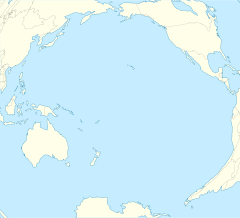
Back Castle Bravo AF قلعة برافو Arabic Castle Bravo Catalan Castle Bravo Czech Castle Bravo Danish Castle Bravo German Castle Bravo Spanish قلعه براوو FA Castle Bravo Finnish Castle Bravo French
| Castle Bravo | |
|---|---|
 Film of the Bravo detonation and subsequent mushroom cloud | |
| Information | |
| Country | United States |
| Test series | Operation Castle |
| Test site | Bikini Atoll |
| Coordinates | 11°41′50″N 165°16′19″E / 11.69722°N 165.27194°E |
| Date | 1 March 1954 |
| Test type | Atmospheric |
| Yield | 15 megatons of TNT (63 PJ) |
| Test chronology | |
Castle Bravo was the first in a series of high-yield thermonuclear weapon design tests conducted by the United States at Bikini Atoll, Marshall Islands, as part of Operation Castle. Detonated on 1 March 1954, the device remains the most powerful nuclear device ever detonated by the United States and the first lithium deuteride-fueled thermonuclear weapon tested using the Teller-Ulam design.[1][2] Castle Bravo's yield was 15 megatons of TNT [Mt] (63 PJ), 2.5 times the predicted 6 Mt (25 PJ), due to unforeseen additional reactions involving lithium-7,[3] which led to radioactive contamination in the surrounding area.[4]
Fallout, the heaviest of which was in the form of pulverized surface coral from the detonation, fell on residents of Rongelap and Utirik atolls, while the more particulate and gaseous fallout spread around the world. The inhabitants of the islands were evacuated only three days later and suffered radiation sickness. Twenty-three crew members of the Japanese fishing vessel Daigo Fukuryū Maru ("Lucky Dragon No. 5") were also contaminated by the heavy fallout, experiencing acute radiation syndrome, including the death six months later of Kuboyama Aikichi, the boat's chief radioman. The blast incited a strong international reaction over atmospheric thermonuclear testing.[5]
The Bravo Crater is located at 11°41′50″N 165°16′19″E / 11.69722°N 165.27194°E. The remains of the Castle Bravo causeway are at 11°42′6″N 165°17′7″E / 11.70167°N 165.28528°E.
- ^ "Operation Castle". nuclearweaponarchive.org. Retrieved 23 September 2017.
- ^ Rowberry, Ariana (30 November 2001). "Castle Bravo: The Largest U.S. Nuclear Explosion". Brookings Institution. Retrieved 23 September 2017.
- ^ "Operation Castle". nuclearweaponarchive.org. 17 May 2006. Retrieved 20 May 2016.
- ^ Hughes EW; Molina MR; Abella MKIL; Nikolić-Hughes I; Ruderman MA (30 July 2019). "Radiation maps of ocean sediment from the Castle Bravo crater". Proceedings of the National Academy of Sciences. 116 (31): 15420–15424. Bibcode:2019PNAS..11615420H. doi:10.1073/pnas.1903478116. PMC 6681739. PMID 31308235.
- ^ Foster, John Bellamy (2009). The Ecological Revolution: Making Peace with the Planet. Monthly Review Press. p. 73.
